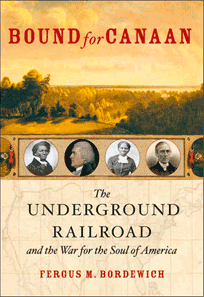
EXCERPTS: From The Intro
REVIEWS: Wall street Journal | Publisher’s Weekly | New Yorker | American Heritage | Civil War History | The Smithsonian | Kliatt | the Washington Post | the afrolumens project | the atlantic
Destination, Freedom
Review by John J. Miller, Wall Street Journal, March 29, 2005
ON A COLD winter night in 1838, a woman carrying an infant fled across the frozen Ohio River. The ice had started to thaw, but she could hear the dogs of her pursuers barking in the distance and decided to push forward. Cracks opened beneath her twice, drenching her in the frigid water. When she finally reached the far shore, she somehow mustered enough strength to stumble to a farmhouse. She and her baby warmed themselves before a fire, received a change of clothes and were led to another home before sunrise.
It was their first stop on the Underground Railroad. Harriet Beecher Stowe eventually heard the story and turned it into one of the most memorable episodes in ‘Uncle Tom’s Cabin.’ In the novel, the woman was called Eliza. In real life, none of the people who helped ‘Eliza’ that night knew her name.
That was typical—and it presents a mighty challenge to historians. The network of abolitionists devoted to helping slaves find their freedom wasn’t described as ‘underground’ for nothing. Records of its operations are scarce. Frederick Douglass urged his allies to keep mum. ‘Let us not hold the light by which [our enemies] can trace the footprints of our flying brother,’ he said.
Yet in ‘Bound for Canaan’ (Amistad, 540 pages, $27.95), Fergus M. Bordewich illuminates the lives and times of the Underground Railroad’s stationmasters, conductors and passengers. He has written an excellent book that is probably as close to a definitive history as we’re likely to see.
WHEN THE Underground Railroad was running, frustrated Southerners imagined it to be much more extensive than it really was. Today Americans are likely to overstate its significance because they want examples of moral virtue to make up for a national stain. As Mr. Bordewich notes, there is a ‘national fairy tale’ quality to the Underground Railroad, and any serious chronicle must break through ‘the hard sheen of myth.’
‘Bound for Canaan’ offers several myth-busting lessons, including the unsurprising fact that few of the movement’s white leaders subscribed to 21st-century notions of racial equality. One of the most influential figures, Levi Coffin, hoped that ending slavery would put a stop to miscegenation.
Yet the primary inspiration for Coffin and his band was religious. In the 1820s, Pennsylvania Quakers developed the idea of concealing fugitives in their attics and cellars and then moving them to new hideaways during the night. The practice spread quickly, especially among evangelicals in Ohio and Indiana. Free blacks played vital roles as well. The revolutionary new technology of locomotives offered a handy metaphor.
What started out as a mishmash of volunteers became a sophisticated system of furtive transportation. Successful escapes involved feeding runaways, giving them new clothes and shoes, and providing them with medical care. Stationmasters also had to procure horses and wagons, dispatch messages, and find ways to pay for it all. It was like running a small business, or perhaps a nonprofit organization, on a shoestring budget. Although money frequently traded hands—many of the conductors who led slaves to liberty were compensated—the motives were almost entirely spiritual.
The Underground Railroad’s trains ran on time because a remarkable group of men and women believed that civil disobedience was their pious duty. Even more remarkable were the runaways themselves, who risked everything for freedom. Relatively little is known about them. In the midst of a movement that left behind few documents, they left behind the fewest.
Yet they occupied the moral center of an admirable cause, and their personal bravery confounded stereotypes. The Underground Railroad, writes Mr. Bordewich, ‘exerted a powerful effect on public opinion by portraying African Americans as bold, resourceful, and independent men and women, rather than the barely tamed savages or docile livestock that proslavery propaganda claimed.’ ‘Bound for Canaan’ recounts a series of compelling characters and harrowing tales, from ‘Eliza’ and her intrepid trek to Harriet Tubman and her daring rescue missions.
There was no such thing as an ordinary journey on the Underground Railroad, though it is possible to describe a number of common features. Most of the slaves who embarked upon it hailed from border states such as Kentucky and Maryland. Ohio and Indiana probably saw the bulk of the activity, with the heaviest traffic concentrated at a group of crossings where the Ohio River was narrow, the roads were good and the locals were sympathetic. The runaways prayed for clear skies so that they could keep an eye on the North Star.
Wintertime escapes were most frequent because it was easier to travel through defoliated forests and dash across frozen rivers. Christmas presented an especially good opportunity since it was a holiday for everyone and slave owners might not immediately notice anyone missing. The final leg of an escape could involve a sleigh ride across Lake Erie to Canada, which was the termination point for as many as one-third of the fugitives. Nobody knows for sure how many runaways took a ride on the Underground Railroad, but Mr. Bordewich says a good guess is 100,000.
The book’s title comes from an old hymn: ‘I am bound for the land of Canaan.’ Once slaves crossed their River Jordan, of course, they were bound no more.
Mr. Miller is a writer for National Review.

